
by Josh Knackert Monday, October 15, 2018
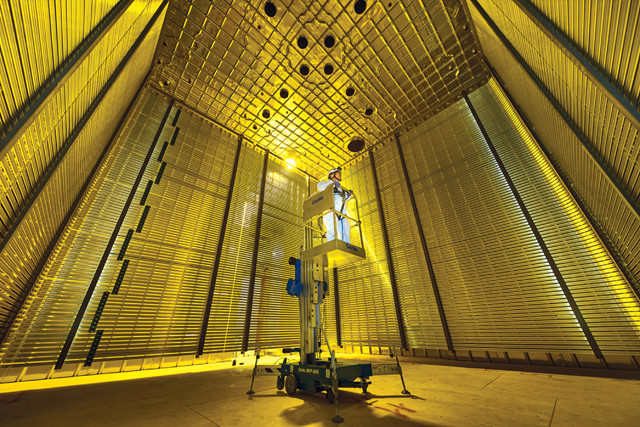
A technician works inside a roughly 500-cubic-meter neutrino detector during its construction in April — one of two liquid argon detectors being built at the European Organization for Nuclear Research's (CERN) facility near Geneva, Switzerland. Known together as ProtoDUNE, the detectors at CERN are prototypes of four larger versions to be built at the Sanford Underground Research Facility (SURF) — housed in the former Homestake Gold Mine near Lead, S.D. — as part of the Deep Underground Neutrino Experiment (DUNE). Credit: CERN.

The headframe of the historic Soudan Iron Mine on a frigid day in northern Minnesota. The mine, which ceased operations in 1962, is now operated as a state park and also hosts scientific research. Credit: Josh Knackert.
At about 5 a.m. on a frigid, icy February day in northern Minnesota — the kind of day when it feels like your eyeballs might freeze — a group of about 10 undergraduates in a geobiology course at the University of Minnesota-Duluth jumped onto a bus, headed for a destination far more temperate and out of the elements — or, rather, deep below the elements. Joined by their professors, microbiologist Cody Sheik and geologist Latisha Brengman, as well as a few others (including yours truly), the students arrived, two hours later and still before daybreak in the Minnesota Northwoods, at the visitor center and museum for the historic Soudan Iron Mine. The mine began operations in 1882 as an open pit mine, but moved underground about 20 years later and ceased mining in 1962.
After hustling into the (mercifully warm) visitor center to watch a video about the former mining operations 800 meters belowground at Soudan, everyone in the group suited up with hard hats and head lamps for a pitch-black, claustrophobia-inducing three-minute descent into the mine aboard a loud, clanging elevator cage — the original mine elevator built around 1900. This was followed by a kilometer-plus-long ride aboard the original mine railway to the deepest part of the mine, and then a guided tour.
The mine and its history are fascinating, as is the buried ore exposed on the walls of the mine — a banded iron formation featuring thinly layered swirls of black and red rock shot through with veins of white quartz. But on this day, the students and their instructors weren’t touring the mine simply to admire some striking Precambrian geology, or to get in out of the cold. There was science to be done.
Sheik and his collaborators have traveled to Soudan several times as part of their microbiology research, and as the sampling techniques they employ are straightforward, Sheik and Brengman saw this trip as a perfect learning opportunity for their students. The group spent the day collecting samples from a rivulet of water running along one side of the mine tunnel. The water was stained bright red, as was pretty much every other surface in sight. The coloration was from iron that had oxidized when exposed to air in the tunnel, essentially rusting the entire mine. Trickles of groundwater running down the tunnel walls concentrated this oxidized iron in the small stream, making the reds extra sharp. Meanwhile, the streambed also displayed a stringy mix of oranges, yellows and browns, almost as if someone had smeared oil paints along its length. These bright, mottled streaks — formed by mats of microorganisms — were what most interested Sheik and Brengman. The group sampled the stream and its populations — filtering suspended microbes out of the water and scraping up portions of the slimy biofilms and mineralized solids in the microbial mats — to take back to their university lab. The sampling was part of a larger effort not only to study the collection of microorganisms inhabiting the mine’s deep tunnels today, but also to address longstanding questions about the origins of life on Earth.
Beyond Soudan, a surprising variety of groundbreaking — and often otherwise impossible — research is being conducted underground all over the world, from investigations of natural resources, seismic activity and carbon sequestration, to less obvious topics like biofuel development and how life began on Earth — and, maybe, on other planets as well. These modern research efforts have their roots in mining: As centuries of ingenuity took us deeper into Earth, scientists realized that subterranean depths and isolation offered conditions and phenomena not available on the surface, either naturally or artificially in laboratories. This holds true today, with established underground research facilities offering scientists from numerous fields unique ways to answer some of science’s biggest questions.
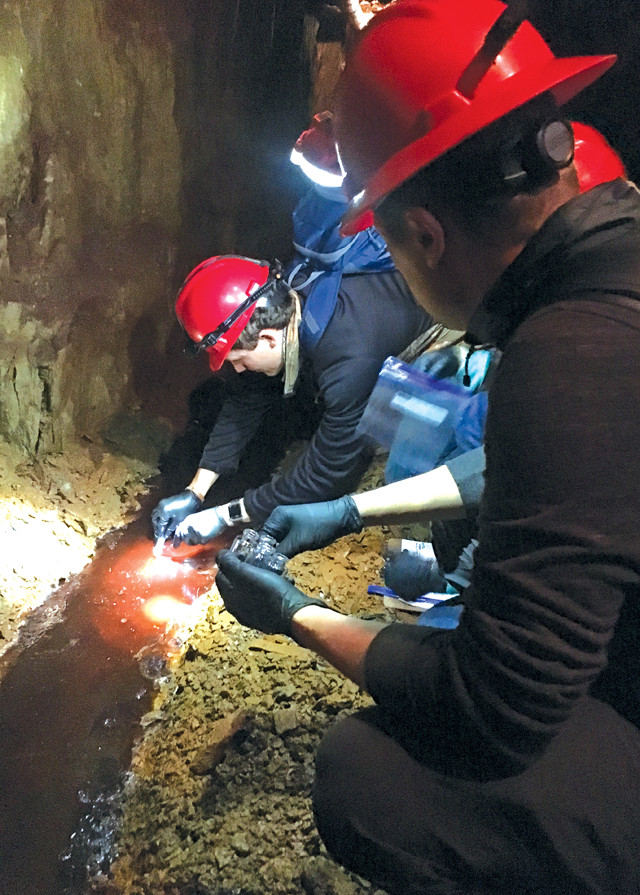
Students from the University of Minnesota-Duluth collect samples from a rivulet of water in an underground tunnel in the former Soudan Iron Mine. Credit: K. Cantner.
Worldwide, there are about 20 deep, underground laboratories — including 10 in Europe and four in the U.S. — buried at depths varying from a few hundred to several thousand meters. Most are former mines, though some have been excavated for the sole purpose of research. One such lab is the European Organization for Nuclear Research’s Large Hadron Collider near Geneva, Switzerland, likely the most renowned subterranean lab facility, which is buried at a relatively shallow depth of about 100 meters. For roughly the last 60 years, researchers from different fields have been drawn to underground facilities for many of the same reasons.
One benefit of underground mines, particularly for physics research, is that thick layers of soil and rock provide what can be referred to as statistical quiet, blocking or attenuating background signals present at Earth’s surface, such as solar radiation, that often drown out or otherwise interfere with the target signal. A kilometer and a half worth of ground cover can reduce the noise from cosmic rays by a factor of roughly 10 million, for example. Physicists often shield their underground experiments further, blocking trace radiation emanating from rocks and even from the human body by encasing detectors in water, lead or other protective materials.
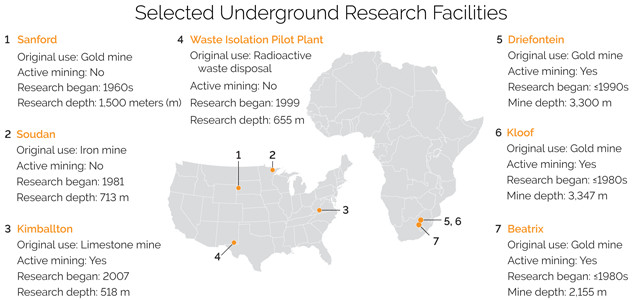
Credit: K. Cantner, AGI.
Another benefit is that underground environments like mines typically remain unchanged for longer periods of time than surface environments. In some deep mines, like the gold mines of South Africa, the same groundwater can remain trapped in a small area for millions of years; and temperatures remain remarkably consistent as well, always staying above freezing. (Tour guides at the Soudan Mine highlight this as a year-round draw for tourists — with temperatures hovering around a comfortable 10.5 degrees Celsius, it’s cooler than muggy Minnesota summers and much warmer than the biting chill of winter.) Furthermore, some mines are located in areas where seismic activity is minimal, reducing their vulnerability to ground shaking. These relatively stable conditions mean that subterranean research facilities can last a long time.
Limitations on oxygen, organic carbon and sunlight deep underground offer conditions thought to be similar to those when life began on early Earth. Subterranean environments also offer analogs for conditions under which life may have begun on other planets, like Mars. Along with high pressure, and sometimes very acidic or dry conditions, these factors create environments that typically make it difficult for anything to survive, much less thrive. Yet even in such places, bacteria and archaea known as extremophiles do thrive; and these microbes may be the closest living relatives to those that first populated the planet.
At Soudan, Sheik and his team find surprisingly complex microbial communities given the limitations of the mine environment. The inherent resilience of these organisms is what interests the researchers most. “We look at what biology can do today [in these extreme environments] and apply that to what we know about Earth 4 billion years ago,” Sheik says. After collecting microbial samples from the mine, they characterize them in the lab using various growth conditions and by sequencing their DNA. The goal is to better understand the mechanisms and key genes that allow the bacteria to grow and replicate in natural environments where resources are sparse.
The slow rate of change and movement in deep subterranean environments may also affect microbial evolution. It’s common for deep-living extremophiles to not encounter other living species for hundreds or even thousands of years. This means there are low rates of predation, symbiosis and gene transfer in these communities. Survival in low-resource environments can also mean slow replication or even long stretches of senescence, conditions that likely affect how genes in these extremophiles activate and change over time. “We don’t fully know how [these microorganisms] eat, reproduce or evolve,” Sheik says. “Advanced genomic tools are helping us understand evolution and the flow of energy through these complex communities.”

Microbial colonies form a stringy mix of orange, yellow and brown hues in a small stream running through a tunnel at the former Soudan Iron Mine. Researchers have found surprisingly complex communities of microorganisms here, considering the limitations of the deep mine environment. Credit: Josh Knackert.

Soudan has hosted several large physics experiments, including the Main Injector Neutrino Oscillation Search (MINOS) project. MINOS ended in 2016, and the large neutrino detector housed in this excavated hall in the former mine has since been dismantled. Credit: Josh Knackert.
Tullis Onstott, a geomicrobiologist at Princeton, studies life in environments even deeper than Soudan, collecting microorganisms in active gold mines in South Africa. The cluster of four active gold mines where he works — the East and West Driefontein mines and the Kloof Mine near Carletonville, plus the Beatrix Mine near Welkom — are some of the deepest excavations in the world, reaching down as far as 3.4 kilometers below the surface. These depths offer even more challenging living conditions, including elevated temperatures due to increased geothermal activity. And the pressure is so great at these depths that boreholes drilled by the mining company close in a matter of months; most significant cracks or fissures formed by gradual rock movement and seismic activity meet similar fates.
Despite the harsh conditions, “we find very active communities adapted to their environment,” Onstott says. Single-celled life living several kilometers down once seemed unlikely enough, but in 2011, Onstott and his collaborators discovered microscopic worms called nematodes living in the extreme conditions of the Beatrix Mine. “We were startled to find multicellular organisms,” he says. “They’re feeding off the bacteria,” and the worms may also have bacterial symbionts, which altogether suggests a more complex food web in the subterranean than was previously assumed. His team has also found a surprising diversity of viruses underground, increasing the complexity of potential flows of genes and nutrients among organisms.
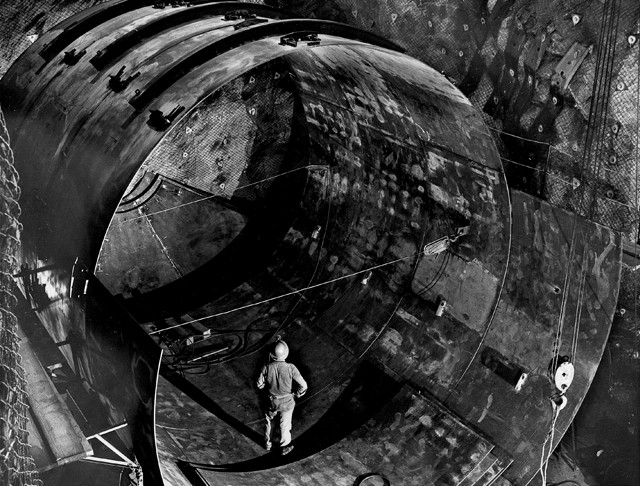
The Davis experiment, housed in the former Homestake Gold Mine (now SURF) in South Dakota, was one of the earliest large-scale underground physics experiments. Making use of a 380-cubic-meter tank filled with perchloroethylene, the experiment successfully confirmed the existence of solar neutrinos and offered evidence that neutrinos come in three "flavors" — results that later garnered project leader Ray Davis a Nobel Prize. Credit: Anna Davis, Sanford Underground Research Facility, ©South Dakota Science and Technology Authority.
The unexpected level of diversity and complexity in life deep underground is offering researchers an array of opportunities to ask key questions about the origins of life on this planet and others, like how the genetic building blocks common to all life came into being and how cells gained the ability to produce energy through respiration. Researchers are also looking into whether multiple forms of life might have evolved in parallel here on Earth — and, thus, if one early form of genes outcompeted others — as well as what life on Mars might have looked like if it did evolve.
While biologists are exploring the origins of life, physicists are using underground research facilities to ask questions about the origins of the universe. They were drawn underground by the radioactive quiet after finding that a thick layer of rock blocks the vast majority of cosmic radiation that continually falls on Earth from the sun and other celestial sources.
This radioactive quiet allows incredibly sensitive detectors to record the trajectories of subatomic particles called neutrinos, which are produced by the decay of radioactive elements in the sun and in distant, high-energy events like supernovae, black holes and gamma ray bursts. Because the particles are unaffected by magnetism due to their lack of charge, and because they typically pass unimpeded through matter, they travel, essentially unchanged and along straight trajectories, through the universe at near the speed of light. In the rare instances, however, when neutrinos collide with atomic nuclei, the collisions produce quick flashes of light that can be picked up by detectors. Physicists thus consider neutrinos as messenger particles coming directly from whatever high-energy event created them and use the particles to learn more about those sources and other aspects of the universe that we know little about, like the balance between matter and antimatter and the origin of the universe.
Neutrino research is one of the primary objectives of the Sanford Underground Research Facility (SURF) in Lead, S.D., the deepest research facility in the U.S. at about 1.5 kilometers depth. The lab is in the former Homestake Gold Mine, where gold was mined from 1876 to 2002, after which it was converted into a dedicated research facility. However, the mine has a long history of physics experiments, beginning with the Davis experiment in the mid-1960s. Led by Brookhaven National Laboratory physicist Ray Davis, who was awarded a Nobel Prize in 2002 for the work, researchers looked to confirm that the sun emits neutrinos. The instrument built by Davis’ team at SURF did indeed detect solar neutrinos, but, oddly, only at one-third of the predicted rate. As subsequent experiments would confirm, this wasn’t a case of an inaccurate detector, but rather one of the first signs that neutrinos come in three types, or flavors: electron neutrinos, the type observed by the SURF detector, as well as muon and tau neutrinos.
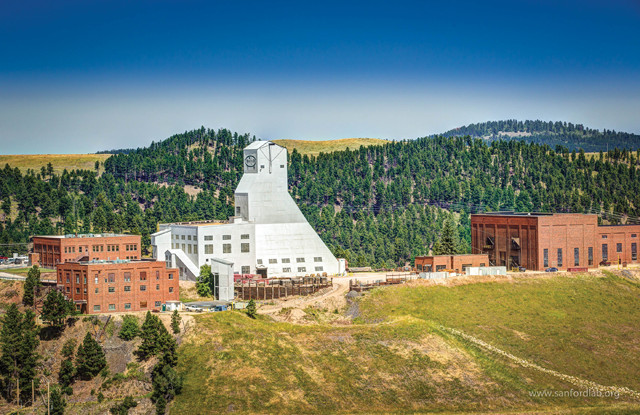
Historic core samples and cataloging of information at the old Homestake Gold Mine have helped engineers and scientists at SURF better understand physical features of the local rock, which saves time and money when it comes to contemporary excavation efforts there. The headframe of the Yates Shaft (seen here), which opened in 1938, serves as the main access for people and equipment to get deep underground. Credit: Matthew Kapust, Sanford Underground Research Facility, ©South Dakota Science and Technology Authority.
Construction of a next-generation detector broke ground in 2017 at SURF. The new detector will take a decade to build and is part of a massive, international research collaboration known as the Deep Underground Neutrino Experiment (DUNE), which brings together roughly 1,000 scientists from more than 160 laboratories in 30 countries. In addition to the detector at SURF, the other main piece of DUNE is the source of neutrinos, which is a particle accelerator at the Fermi National Accelerator Laboratory (Fermilab) in Batavia, Ill. The accelerator will send a concentrated beam of neutrinos through Earth to the detector at SURF, about 1,300 kilometers away, where only a small fraction of the original neutrinos is expected to be detected. Researchers are interested in how these neutrinos scatter and change after interacting with other subatomic particles during their underground trip. The detector at SURF will also be able to observe high-energy neutrinos passing through Earth from cosmic sources like supernovae.
“DUNE is designed to be maximally sensitive based on current limitations,” says Jonathan Paley, an associate scientist at Fermilab. The high-resolution detector at SURF, the largest of its kind, “can see neutrino interaction events in three dimensions with unprecedented resolution,” Paley says. This level of detail will help the DUNE collaboration elicit as much information as possible from these messenger particles, including their energy, flavor and even potentially their incoming direction, among other features. The more researchers can determine about the features of a given neutrino, the better they can understand where it came from and the intense physical events that created it. The neutrino researchers involved with DUNE hope to answer outstanding questions about the universe regarding the balance between matter and antimatter, the stability of matter and what happens inside supernovae, as well as to expand our understanding of fundamental physics in our universe and reveal processes we haven’t yet observed.
ning operations have proved, on the whole, to be a major blessing for underground research efforts. In his research studying deep-dwelling microbes, Onstott says he appreciates having access to unsullied portions of rock as mining operations continually expose fresh surfaces through drilling and blasting. Fresh exposures sometimes provide access to organisms only recently exposed to oxygen and that may have been undisturbed for tens of thousands of years. However, for scientists working in active mines, ongoing operations can be a nuisance as well. When and where research can be conducted is up to the discretion of mine owners; and the same blasting that exposes fresh rock also limits the amount of time researchers can spend in the mine. “Everything has to be planned in advance and we’re running a lot of the time. We want to get in as much [sampling and placement of collection equipment] as possible before the mine is cleared for blasting at the end of the day,” Onstott says.
That’s not an issue at decommissioned mines, though. At the Homestake Mine, which houses SURF, “there are no competing interests, and research is what it’s all about,” says Constance Walter, communications director at SURF.

The DUNE project, construction of which is underway, involves four massive detectors 1.5 kilometers below the surface at SURF that will study neutrinos produced by an accelerator roughly 1,300 kilometers away at the Fermi National Accelerator Laboratory in Illinois. The current timeline calls for two of the detectors to be online by 2026. Credit: Fermilab.
Past mining efforts can tell researchers a lot about the physical features of rock surrounding a mine, as well as about how the rock formed, past seismicity in the area and other useful information. “The Homestake Mining Company did a tremendous job of cataloging the rock,” Walter says. “We’re lucky to still have their historic core samples.” And researchers working at Soudan have benefitted in the same way, with historical core samples inherited after the mine was taken over by the state. Being able to use these past records offers essential time and financial savings compared to drilling new holes or excavating from scratch. William Roggenthen, a geological engineer at the South Dakota School of Mines and Technology, studies the mechanical properties and behavior of soil and rock as part of the SURF collaboration. Such work is relevant in understanding expected behaviors of materials in applications related to construction, mining, dams and geothermal development, as well as in developing new materials. Conducting this type of research on deep natural rock formations is typically very difficult to justify economically. But at SURF, he “can get up close and personal with the rock mass I want to investigate in a cost-effective manner,” Roggenthen says.
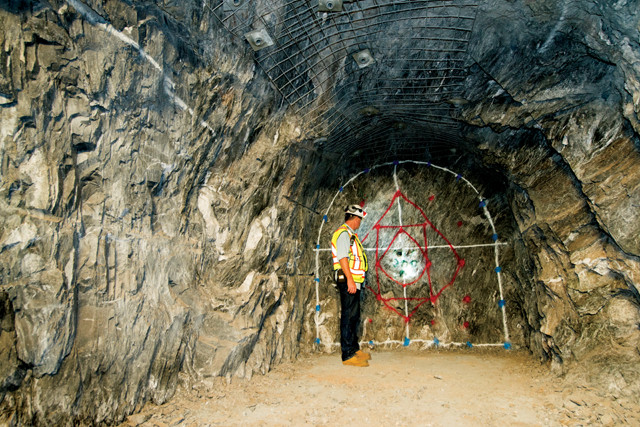
Before the DUNE detectors can be built at SURF, roughly 875,000 tons of rock must be removed, requiring detailed planning, test excavations, as seen here, and careful execution. Credit: Sanford Underground Research Facility, ©South Dakota Science and Technology Authority.
Sometimes, though, further excavation is necessary once a mine is turned into a research facility. At SURF, for example, engineers must still excavate a volume of rock the size of a small warehouse more than a kilometer underground to house the massive detectors required for DUNE. To accomplish such feats, underground research facilities bring in civil engineers, including many who typically cut tunnels for roads and subways.
Typical mining excavation values the volume of rock moved and doesn’t care much about the quality of the walls or long-term stabilization of large caverns," says David Vardiman, a geotechnical engineer who is in charge of the SURF excavation. Every step of the process for creating these research facilities requires more precision, especially in the blasting patterns. Rock walls are meticulously smoothed and stabilized with cable and concrete. The final product looks more like an airplane hangar than a cave. While the construction deviates from typical mining protocols, knowledge of a mine’s history is vital. The 140-year history of excavation at the Homestake Mine provides “a better understanding of how the rock mass will react to excavation,” Vardiman says. The historical drilling cores also helped engineers select the region of the old Homestake Mine that was most amenable to a large-scale excavation. Such engineering and attention to detail lead to huge underground spaces that can last several decades.
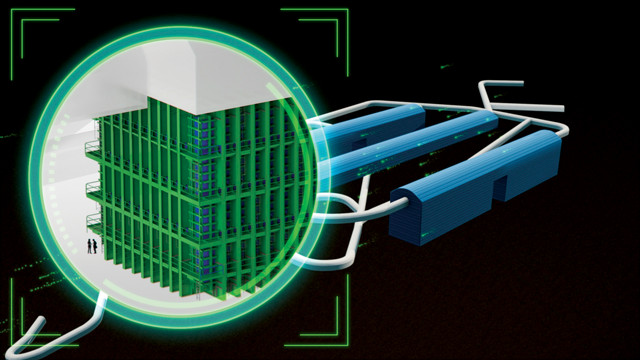
The Neutrino-sensing DUNE detectors will each hold 70,000 tons of liquid argon. Credit: Fermilab.
Many subterranean experiments generate a lot of buzz given their unorthodox settings and their engagement in answering fundamental science questions. This attention offers a certain amount of staying power for these projects, with many of the larger ones slated to run for several decades. “DUNE is a very exciting program,” Paley says. “It offers a broad research program, touching on a number of key topics, that will keep us busy for a long time to come.”
In addition to those studying the origins of life and particle physics, researchers in many fields are capitalizing on the accessibility of unique underground environments to undertake a variety of investigations. Computer hardware companies have placed hard drives underground to evaluate whether cosmic rays damage data storage; seismologists have installed geophysical arrays sensitive enough to detect ripples from tsunami waves reaching the West Coast of the U.S. from as far away as the Indian Ocean; and microbiologists have isolated bacteria from rotting mine timbers that could help produce more efficient biofuels. The isolation that draws researchers underground also offers an appealing trap for things that need to stay put for a long time, like radioactive waste or carbon captured from power plants or the atmosphere.
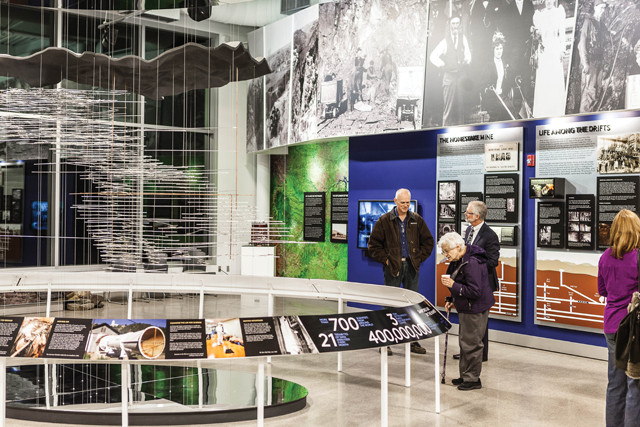
SURF is home to a visitor center full of exhibits in an effort to maintain public support for underground research facilities, most of which are supported at least in part by public funding, Credit: Matthew Kapust, Sanford Underground Research Facility, ©South Dakota Science and Technology Authority.
Despite the wealth of potential from underground research, there are persistent challenges for facilities hosting such work. As with virtually all research, funding is the big unknown. Researchers working in active mines are often dependent on a mine’s profitability. Maintenance of deep excavations is incredibly costly. If a pumping system isn’t maintained, mines slowly fill up with groundwater. For example, between the time the Homestake Mine was fully decommissioned in 2003 and when it became a full-time research facility in 2007, the mine slowly filled with water. Before construction could begin on the research spaces, the mine had to be pumped out and refurbished.
ombined with other bare necessities, like circulating fresh air, performing regular safety checks and operating mine cages, costs can easily reach hundreds of thousands of dollars per year for individual mines. “The South Africa mines are beginning to shut down [due to decreasing profitability], meaning we will eventually lose our access,” Onstott notes.
Soudan and SURF each depend on a mix of public and private funding, but those sources are also finite and prone to fluctuation. Soudan relies heavily on state funding as a state park, meaning budget cuts or low tourist attendance could close the mine and spell the end of research there. SURF was established with a private $70 million donation from T. Denny Sanford combined with $40 million from the state of South Dakota, but it continues to get grants from the National Science Foundation and the Department of Energy as well.
Fostering collaboration and highlighting return on investment are keys in maintaining public support for these facilities, a point often reiterated by the people involved in their operation. As part of his donation, Sanford required that SURF promote education and outreach. That directive is fulfilled with a visitor center offering detailed information to guests, as well as with internships, fellowships, activities for student groups, and collaborations with several nearby universities that support a variety of local jobs. A dedicated education and outreach staff has also developed curriculum kits that are sent to classrooms in South Dakota and beyond. These kits “are especially popular as they give teachers … the opportunity to incorporate hands-on, inquiry-based science units into their classrooms,” Walter says, noting that other national and international laboratories have contacted SURF for help in developing their own educational lesson plans.
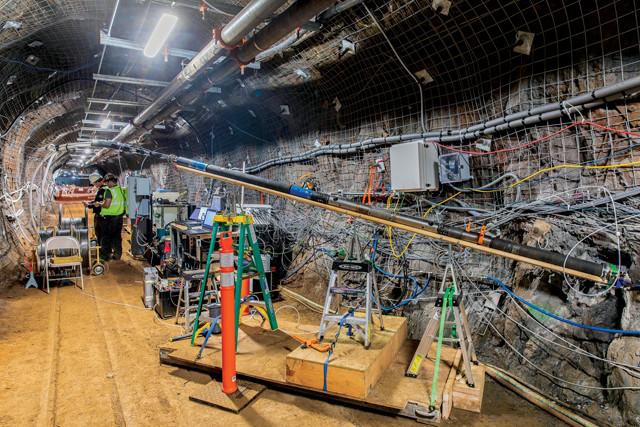
Underground research facilities house scientific investigations beyond just particle physics and microbiological experiments. At SURF, for example, researchers have begun studying rock mechanics and geothermal systems as part of the Stimulation Investigations for Geothermal Modeling and Analysis project. The project involves drilling several boreholes for injection and production of geothermally heated water, as well as for monitoring. Credit: Sanford Underground Research Facility, ©South Dakota Science and Technology Authority.
At Soudan, Sheik, Brengman and the retired miners who still work at the site, giving tours and running the museum, all hope that enough tourists visit the mine to keep it going, perhaps lured by curiosity about the captivating iron-rich rocks 800 meters below the surface or the chance to eat lunch in a historic mining operation while sitting on boxes labeled “TNT/explosives.” They also hope that more researchers realize the upside of working underground — where the potential science to be done is as exciting as the subterranean environment itself.
“These are such unique environments to ask important questions,” Onstott says. “It’s the lack of access that always kills us,” never a lack of new questions.
© 2008-2021. All rights reserved. Any copying, redistribution or retransmission of any of the contents of this service without the expressed written permission of the American Geosciences Institute is expressly prohibited. Click here for all copyright requests.